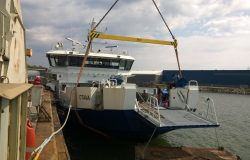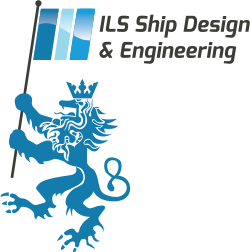Main dimensions:
Length, max: 34.9 m
Width, molded: 9.0 m
Draught as a ferry: 2.4 m
Draught as an oil recovery vessel: 2.65 m
Propulsion power: 1,000 kW
Oil collection capacity: 100 m3
Class notation: Bureau Veritas 1 + Hull + Mach, General Cargo ship, Roro Passenger ship, AUT+UMS, Ice class 1A
We were commissioned by the ship owner FinFerries to draw up a concept for a commuter ferry intended for the demanding conditions of the Kotka archipelago. Under the leadership of the shipping company’s manager, Mr. Veijo Hiukka, planning was carried out both by getting to know Kotka’s island routes on site and in several planning meetings in both the shipping company’s and our offices – both of which were then located along the street called Puutarhakatu in Turku. The planning cooperation went smoothly – after all, several archipelago ferries had been designed and built together before this: Sister ships Aura and Aurora were the first, before that sister ships Kaita and Kivimo as well as Bastö and Bergö.
The idea to include an oil spill response capability in the new commuter ferry arose from the shipping company’s experience with the narrowness of the shipping lanes in the Kotka area and the fact that the locations of Finland’s oil spill response vessels were far away. We wanted a vessel that always runs in the area of the Kotka archipelago, and has first response readiness for oil control. The goal was to get the ship to have the ability to limit the extent of possible damage and even to collect oil spilled into the sea until larger oil response vessels could arrive. Such a combination was designed and also patented in the name of the shipping company.
The ELY Center, which is responsible for ferry traffic, included in the tender a requirement for the vessel to be equipped for oil spill first response duty. FinFerries was awarded the contract for running one such vessel for several years on a new vessel in the Kotka archipelago. The construction of the ship was ordered from UKI Workboat Ltd.
At the project’s kick-off meeting on February 13, 2013, Trafi, which is responsible for ship safety, and Bureau Veritas, which is responsible for technical classification, faced a new challenge, because the existing rules did not apply to the combination as such. Even though there are no passengers or cars on board for oil spill work, it was necessary to agree on how the change from a passenger ship to the role of a tanker meant for oil combating should be implemented. UKI Workboat Ltd and the main designer ILS Oy received good instructions, and the design and construction of the ship began quickly and it was completed the following year, in August 2014.
The vessel has two separate operational functions: a D-class passenger vessel and an oil collection vessel, in which case it is a cargo vessel.



